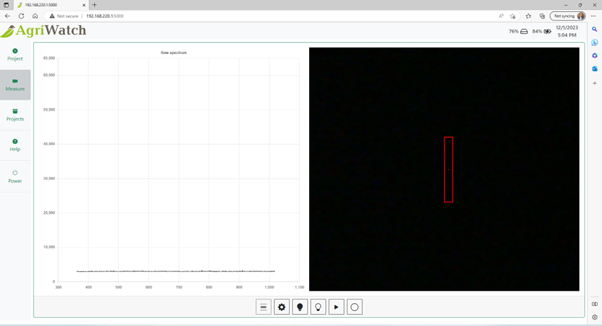Concept of CoSpectroCam (CSC)
Started in 2011, registered in i-DEPOT number 057745 on 2014-08-10 and is valid until 2024-08-10. The development of its implementations are ranging from Indoor, Ground-based to Drone-based systems for different applications. The FOV of the spectrometer is called “Slit Rectangle” (Red rectangle overlay shown on the RGB image).
What is a CoSpectroCam (CSC)?
CoSpectroCam (CSC) is an optical coaxial assembly of an RGB Camera and a Spectrometer. The Field of View (FOV) of the spectrometer is mapped as a rectangle onto the RGB image making a link between the spatial features in RGB and the spectral features derived from the reflectance spectra. This rectangle is called “Slit Rectangle“.
CSC has a Hyperspectral sensor plus an RGB Camera, which are coaxial and synchronized. It is an integrated RGB camera with a spectrometer that acquires spectra registered with RGB images: CoaxialSpectrometerCamera (CoaxialSpecCam - CSC) or CoSpectoCam (CSC).
Current versions of Spectrometer:
CSC2048 USB2000/Flame (2048 spectral channels)
CSC1024 STS (1024 spectral channels)
CSC is a unique laboratory, field, and aerial instrument. The function is to provide hyperspectral data which are precisely referenced to a camera image. The following list illustrates the advantages of using CSC:
It simultaneously acquires coaxial RGB images and spectra identified by timestamp and GPS location.
The FOV of the spectrometer is mapped to the RGB image and displayed on the monitoring screen.
RGB images are used to guide the FOV of the spectrometer to optimal view angles and record the RGB image together with the spectrum (hyperspectral data).
The system can support fieldwork in remote sensing or environmental engineering.
No fiber optic cables are needed for hyperspectral data acquisition.
Spectral data acquisition from any distance to the location of the object (for example, from the ground looking at the sky or clouds). See the above concept image of CSC.
Spatial features such as homogenous areas or texture features are stored along with spectral features in one record identified by the timestamp.
A White reference avoids the use of sky-light models. Instead of using White references in optional sky-light spectrometer provides real-time sky-light full spectra which are used to produce real-time reflectance data. For example, see the below figure with the White reference in the top right of the RGB sub-image and produced reflectance spectrum on the left window.
Field data collection using CoSpectroCam (CSC), 5 August 2014
Lutterzand Nature & Wildlife Areas, De Lutte, The Netherlands. The hyperspectral data (left window) are not from the soil under investigation, where we assume we looked at soil but instead looked at the arm (shown on the camera window - right RGB image).
Spectral features - produced with a spectrometer: The CSC1024 (STS spectrometer) or CSC2048 (USB/Flame spectrometer) spectral channels of the spectrometer provide hyperspectral data for the analysis of spectral features in reflectance and absorbtance in Visible and Near-Infrared (NIR). This high resolution is provided over a well-defined narrow FOV (field of view) called SlitRectangle. The SlitRectangle is the small opening in our optical integration part of the CSC that allows light to enter the spectrometer. The FOV is pointed at areas of homogeneous spectral properties, visible in the RGB camera image.
Spatial features - produced with an RGB camera: are derived from the coaxial RGB image. The camera supports HD (high definition) but is mainly used for geo-referencing the spectrum or taking the SlitRectangle. Advanced software detects the boundaries of the object surrounding the FOV of the spectrometer.
Hyperspectral data + RGB images (overlap at SlitRectangle or FOV spectrometer for hyperspectral data acquisition). As an example, vegetation analysis such as vegetation cover percentages, individual leaves, their size and area parameters can be generated using the collected RGB image in the image processing software. Finally, these parameters can be related to the hyperspectral features.
Dark correction using coSpectroCam connected to a laptop (Wireless)
White calibration using coSpectroCam connected to a mobile app (Wireless)
RGB images are used to guide the FOV of the spectrometer to optimal view angles
Vegetation and Soil measurements using coSpectroCam
CSC comes with software with a GUI that connects the spectrometer and camera for hyperspectral and spatial data acquisition. The data are stored as images and Spectra tables with a common timestamp as reference. The Spectra data are stored in table.csv format and hence easily accessible for further use and analysis. The software also includes options for taking DarkObject, WhiteObject, and Object measurements of radiance and reflectance.
White calibration - the object is the absolute white reference under local irradiance. The CSC software interface for RGB image showing the White reference image and the FOV of the spectrometer imaged on a SlitRectangle (right) with an interface that displays the reflectance spectrum (left).
As shown in the above figures, the CSC-cable/WiFi versions software interface consists of two monitoring windows (one for the RGB camera and one for the spectrometer) for data acquisition, displaying, monitoring and storage of RGB & hyperspectral data.
The CSC acquires Hyperspectral data registered with RGB images.
The camera window shows the FOV of the spectrometer imaged on a Black or Red rectangle. The colour of the SlitRectangle can be chosen based on the preference of the user. Thus, the SlitRectangle defines the FOV of the spectrometer.
It has two sensors; a spectrometer plus an RGB camera. The sensor is called Coaxial Spectrometer Camera - CSC (old name (M3X)SpectroCam since 2011) which is an optically integrated RGB camera with a spectrometer to provide hyperspectral data for the region of interest. As such, the CSC is designed for the combination of both spectral and spatial measurements. These measurements are required for spectral – and spatial pattern recognition.
CSC is a multi-use system and the development of its implementations are ranging from versions based on Tripod/Machine (fixed) to Drone platform-based systems. The cable version is connected to a laptop via USB cables only. The drone or WiFi version is a wireless version and is suitable for use in UAVs.














